Day trip to – Corinth Canal, Mycenae, Nafplion, Epidaurus
We had booked a viator guided tour to these places from Athens. It was a full day (8 hours) trip. we were picked up from our hotel by the viator guide at 8 am. Our first stop was the Corinthian Canal.
Corinth Canal – This is an artificial canal that connects the Gulf of Corinth in Ionian Sea to the Saronic Gulf in the Aegean Sea. It cuts through the narrow Isthmus of Corinth and separates Peloponnese from the Greek mainland, making the peninsula an island. The canal which was completed in 1893, was dug through the Isthmus at sea level and has no locks. It is 6.4 km (4 miles) in length and only 24.6 metres (80.7 feet) wide at sea level. Due to the canal’s narrowness, navigational problems, and periodic closures to repair landslides from its steep walls, it failed to attract the level of traffic expected by its operators. It is still one of the most significant infrastructural feats the world had ever seen and one of the greatest engineering achievements of its time. It is a free attraction and a popular destination for tourists.



Mycenae – Entry to the archaelogical site and the museum €12. Mycenae is an archaeological site in the north-eastern island of Peloponnese. It is one of the great cities of the Mycenaean Civilization that existed during the the Bronze Age from 1600 BC – 1100 BC. The acropolis was built on a hill 900m above sea level. At its peak in 1350 BC, the citadel and lower town had a population of 30,000 and an area of 32 hectares (79 acres). It is now a UNESCO World Heritage Site.

You will need at least 2 hours to explore the points of interest in this archaelogical site:
- Cyclopean wall
- Lion Gate
- Grave Circle A
- Palace
- Subterranean Cistern
- Archaelogical Museum
- Treasury of Atreus
The Cyclopean wall at Mycenae is a prominent archaeological feature that dates back to the Late Bronze Age. It is named after the mythical Cyclops, as the large stone blocks used in its construction were thought to have been placed by these mythical creatures. Built in the 13th century as a defensive fortification for the citadel, the wall is made up of massive limestone blocks, some weighing several tons, which were fitted together without mortar.

Mycenae, Lion Gate – This is the citadel’s main entrance to the city and was erected in the 13th century BC. It is the best-preserved structure in the complex. The intricate Lion sculptures at the top showcases the advanced artistic skills of the Mycenaean civilization. Also, Lion symbolizes power and strength.
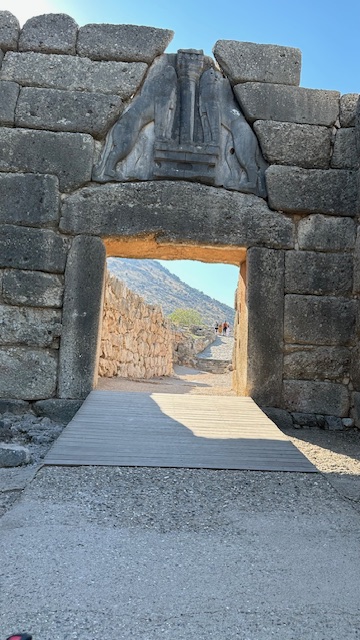


Mycenae, Grave Circle A – After walking through the Lion’s Gate, there are several spots of interest starting with the Grave Circle, which Is a circular burial ground that dates back to the late Bronze Age around 1600-1500 BC. It was discovered in 1876 during Mycenae excavation. The graves were basically large pits dug into the ground, lined with stone slabs and covered with a mound of earth and were richly furnished with a items like gold jewelry, weapons, pottery etc.

Mycenae, Palace – You then walk up a steep path and you will reach what archaeologist think was the Palace. You will see a series of rooms with a courtyard, porch area, followed by a vestibule and then a Megaron. You can see remains of columns that might have supported the roof of the porch.

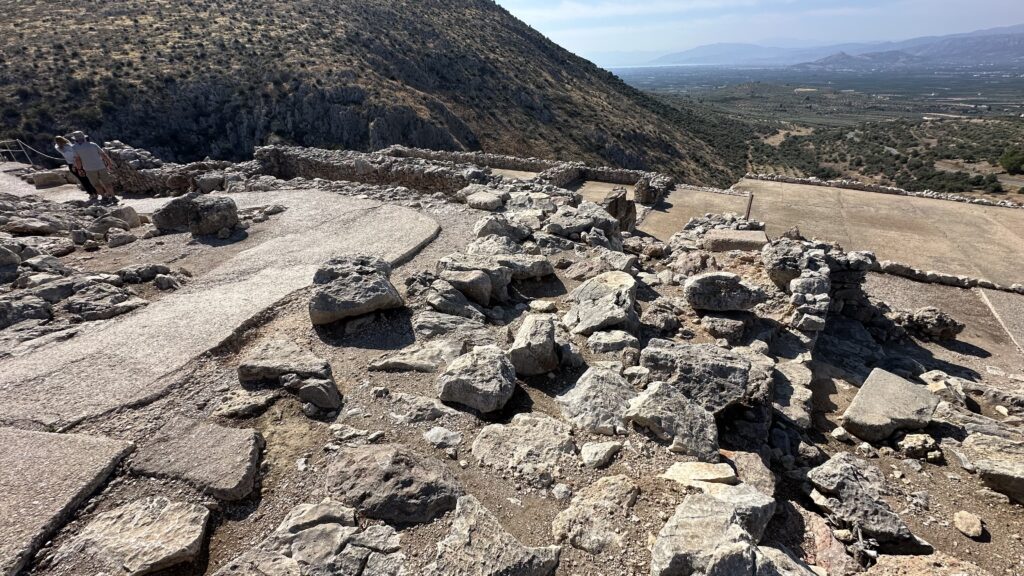
Mycenae, Cistern – You continue walking down the ruins and you will reach the Cistern which is an ancient underground water storage system in Mycenae. It was built during the late Bronze Age, around the 14th century BCE, and is believed to have been used to collect and store water for the city’s inhabitants during times of drought or siege.



Archaelogical Museum of Mycenae – The museum is quite compact and does not take too much time to go through. The exhibits here come from Mycenae and the wider region and represent time periods from the Copper Period around 3,000 B.C. till the Hellenistic time in the 2nd century B.C. Most of the exhibits, are ceramic vases, jewelry, wall paintings, tools, and weapons.
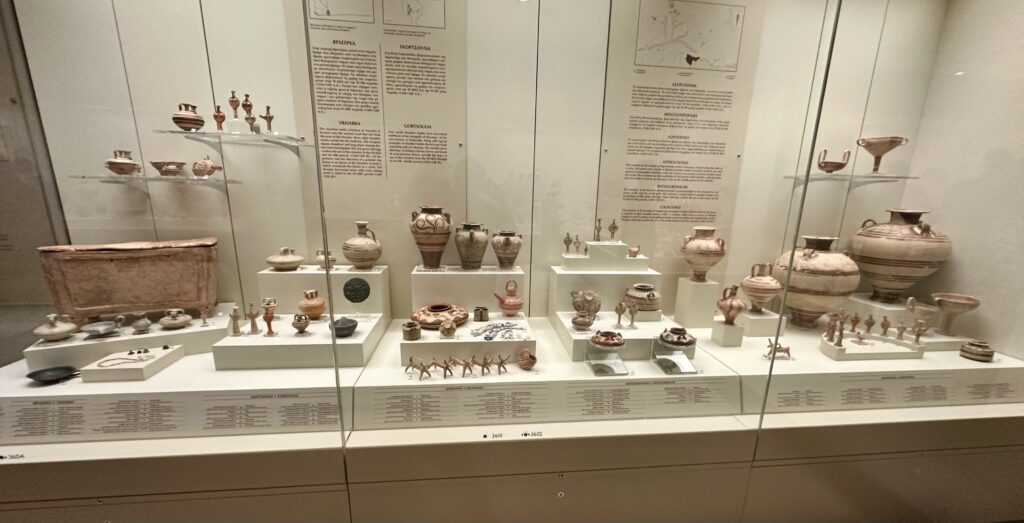
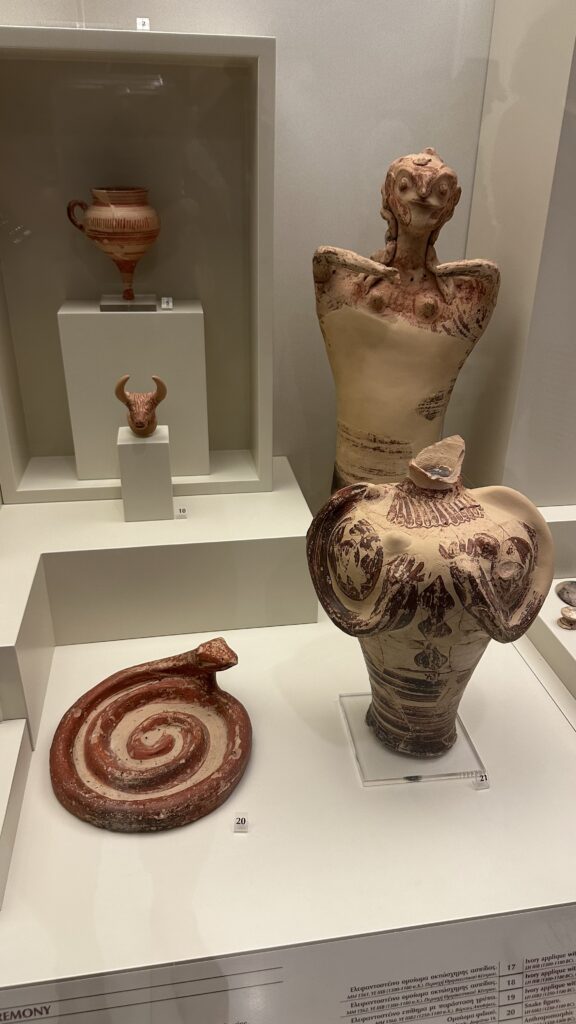


Treasury of Atreus or Tomb of Agamemnon – After we were done exploring the Archaelogical site and museum, the guide drove us to the Treasury of Atreus which was 10 min away. This is a tholos tomb or beehive tomb constructed around 1250 BC for King Agamemnon. The stone lintel above the doorway weighs 120 tons, with approximate dimensions 8.3 x 5.2 x 1.2m, the largest in the world.



Nafplion – After exploring Mycenae, we were driven to the Palamidi Fortress located above the city of Nafplio. €8/person entry fee to the fortress. The fort was built to serve the Venetian military and naval operations of that era. Completed in 1714, it is truly impressive and preserved in excellent condition. It is one of the most important achievements of Venetian fortification architecture.
There are 2 ways to explore the fortress: You can climb up 999 steps to the top or take your car to the parking next to the place. Since we were on a guided tour, we had to go with the 2nd option. The fortress is in well-preserved condition and the view of the Argolic Gulf from the top is stunning.
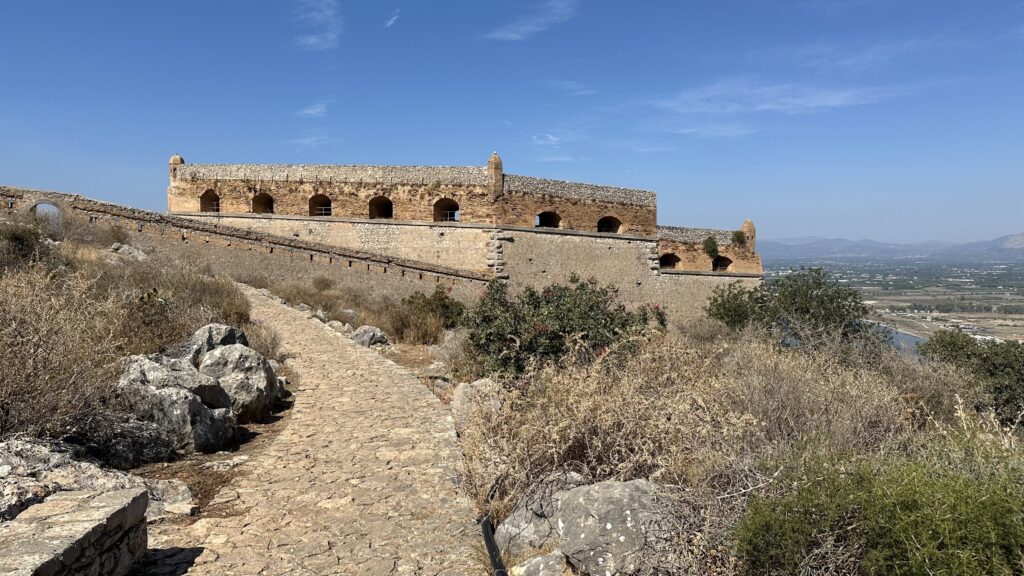




After spending an hour walking and exploring the fortress. we stopped to have Lunch at a restaurant in Nafplio. The Kapodistrias’ Square is strategically located at the entrance of the old town, under Palamidi Castle welcoming visitors. The Clocktower of Nafplio you see from this square was built in the 19th century and is a historical emblem of this charming Greek town.



Epidaurus – Entrance fee €12/person. This was our final stop of the guided tour. You will need to set aside at least 2 hours to go through some of the important highlights of this archeological site. Epidaurus was the location of the Sanctuary of Asklepios, the god of medicine. The vast site, with its temples and hospital buildings devoted to its healing gods, provides valuable insight into the healing cults of Greek and Roman times. All the points of interest in the archaeological site are fairly well labeled with details. You can also download an audio guide onto your phone at the site.
- Ancient Theater
- Archaeological Museum
- Katagogion
- Baths
- Hestiatorion
- Sanctuary of Asklepios
- Tholos
- Stadium
Epidaurus, Ancient Theatre – As soon as you enter the site, this striking theater will catch your eye. Constructed in the late 4th century BC, It is considered to be the most perfect ancient Greek theatre with regard to acoustics and aesthetics. It can seat more than 12,000 spectators and is regarded as the best-preserved theatre in Greece. Over the past 60 years, during the annual Athens Epidaurus Festival, June-Aug, actual performances take place at this theater. The open-air theatre has echoed with the voices of such legends as Maria Callas, Kevin Spacey, and Helen Mirren.


Due to the incomparable acoustics of the theater, the actors can be perfectly heard by all 12,000 spectators. You can even hear the sound of a pin dropping.
Epidaurus, Archaeological Museum – The museum was established in 1902 and opened in 1909 to display artifacts unearthed in the ancient site of Epidaurus and the surrounding area. It is a small museum where you can spend 15 minutes.
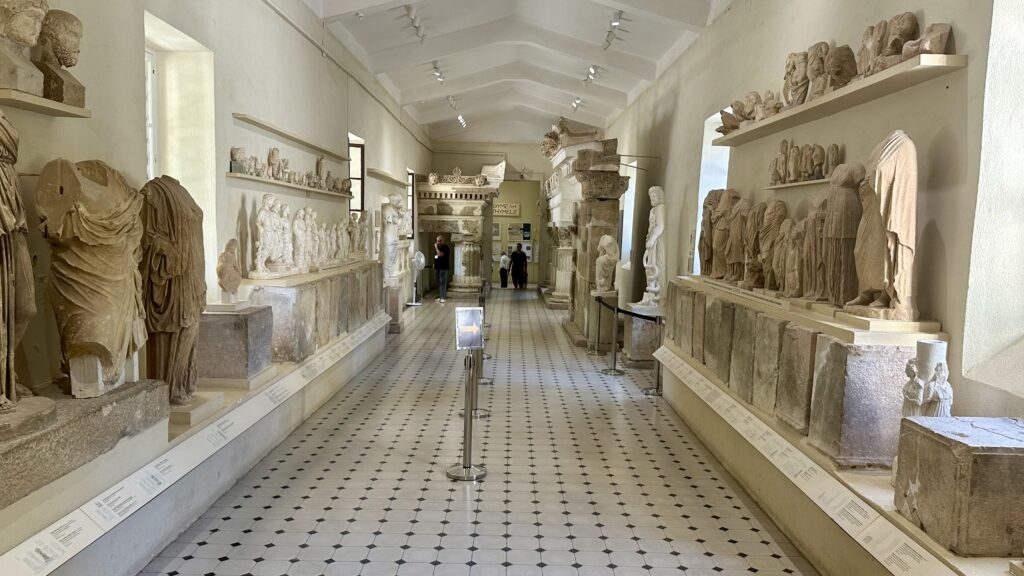
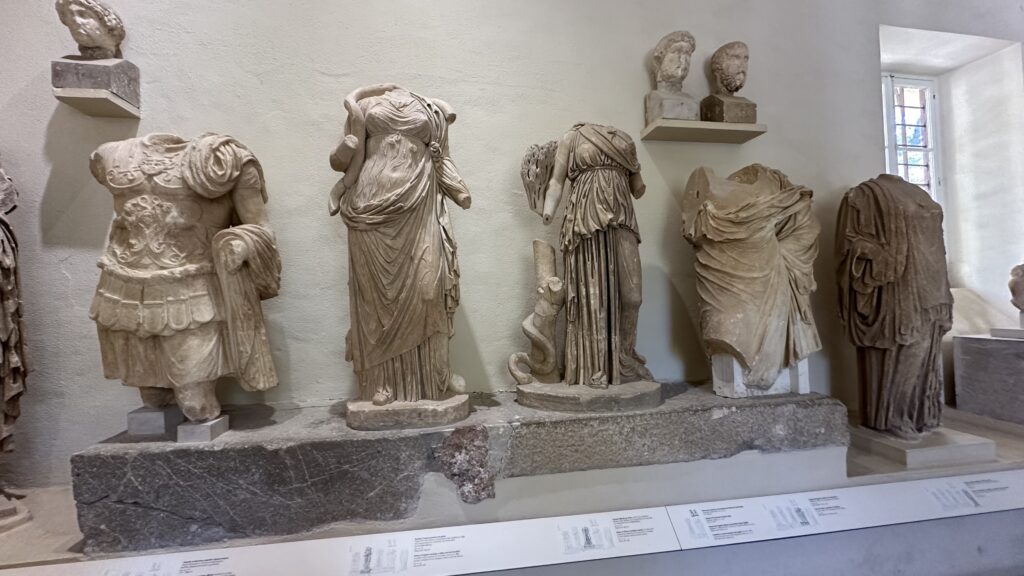

Epidaurus, Katagogion – Built in the late 4th century BC, the Katagogion provided accommodation to the numerous visitors of the Sanctuary, pilgrims, patients, and their companions. In antient times this kind of building was known as Katagogion, which means hostel. The large quadrangular edifice in the picture below consisted of 4 square units, each of which had a courtyard.

Epidaurus, Greek Baths – The bath complex was built around 300 BC. Its early chronology gave it the name Greek Baths, as opposed to other bath buildings of the Sanctuary which belonged to the Roman period. The Greek Bath along with the Stadium which were built around the same time as the hostel provided visitors with facilities during its heyday.

Epidaurus, Stadium – The remains of a 5th century stadium which housed sporting events can be seen here.

Epidaurus, Hestiatorion – The Hestiatorion complex dates back to around 300 BC, and served as a banquet hall where sacrificial meals associated with the cult of Asklepios were held. The complex includes the monumental Propylon, a grand entrance situated on the northwest side, which was designed in the form of a temple. This Propylon features a three-stepped crepis, six Doric columns at the front, and a wide ramp leading to the top, serving as the main entry point to the complex.

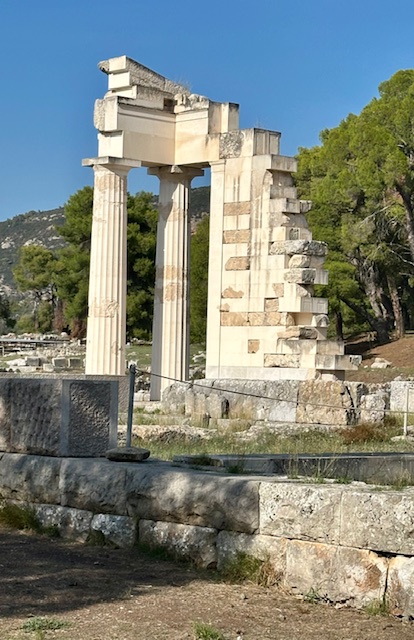
Epidaurus, Temple of Asklepios – The temple was built in the early 4th century BC in the honor of Asclepius, son of Apollo and god of health. The main building found at the archaeological site was the Doric temple dedicated to Asclepius. The temple was six columns by eleven columns, which housed a cult statue of Asclepius which no longer remains. The temple had an abaton, an enclosure where the patients slept and was not accessible to visitors.


Epidaurus, Tholos – This is a circular building next to the Temple of Asclepius, made of white marble with columns surrounding it and is believed to have been a temple. Archaeologists believe that the tholos was the most importance building at the Sanctuary of Asclepius. Its use is uncertain. It may have also been used as an abaton or a place for the priests of the sanctuary to eat. On the day we had gone the Tholos was under restoration and we could not get a good view of the ruin.
